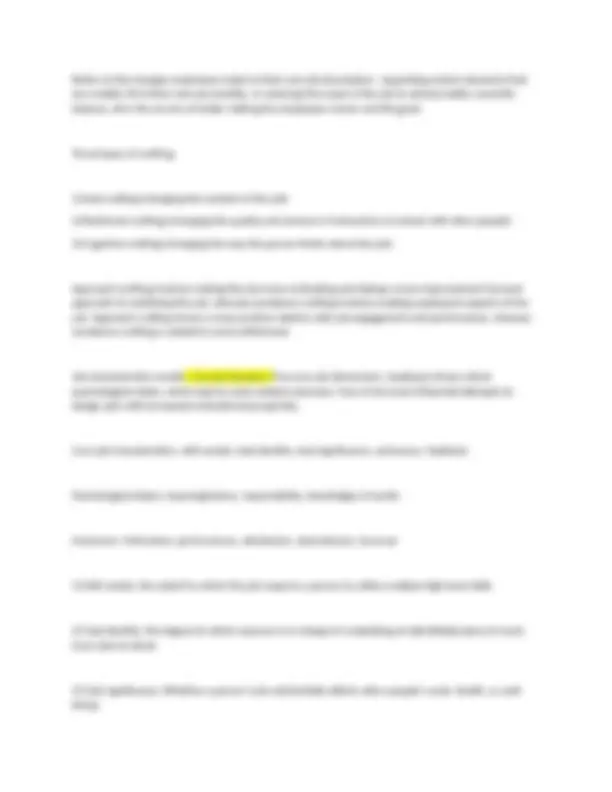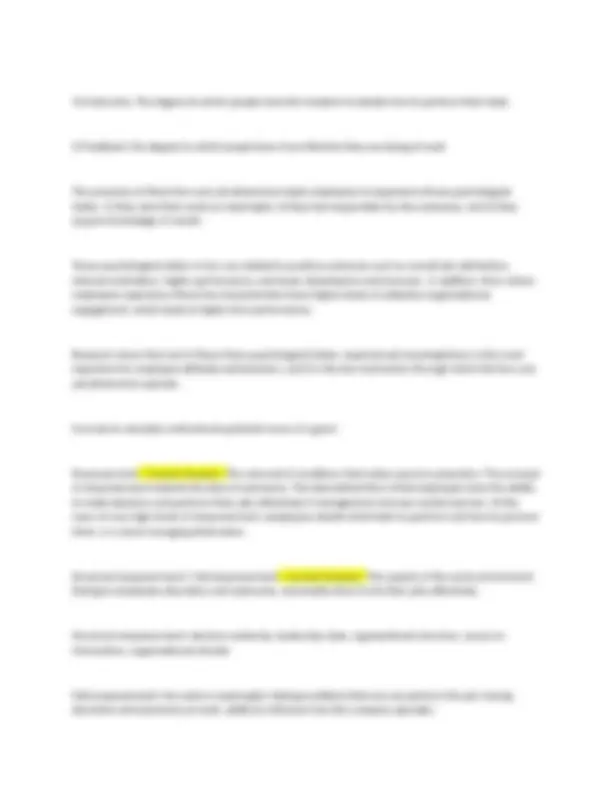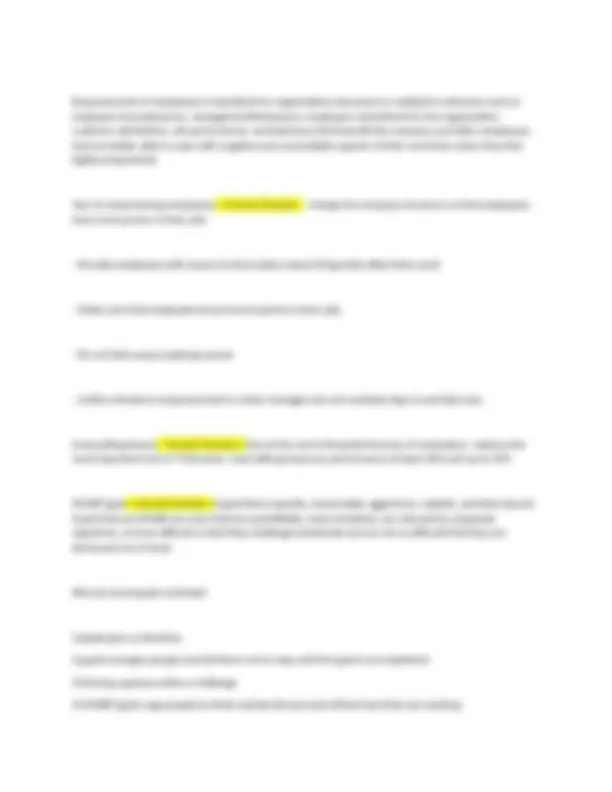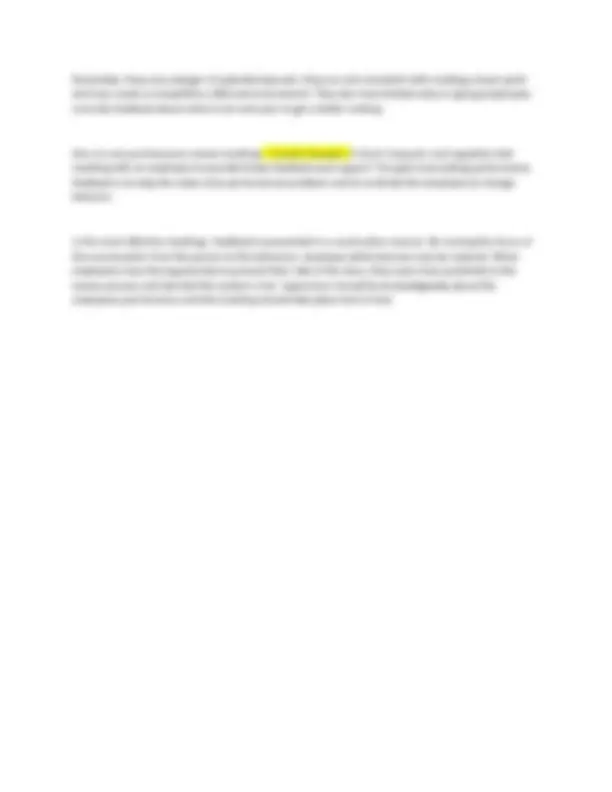






Study with the several resources on Docsity

Earn points by helping other students or get them with a premium plan


Prepare for your exams
Study with the several resources on Docsity

Earn points to download
Earn points by helping other students or get them with a premium plan
Community
Ask the community for help and clear up your study doubts
Discover the best universities in your country according to Docsity users
Free resources
Download our free guides on studying techniques, anxiety management strategies, and thesis advice from Docsity tutors
A comprehensive overview of job design theories and their impact on employee motivation. it explores various approaches such as job specialization, rotation, enlargement, enrichment, and crafting, examining their strengths, weaknesses, and practical applications. the document also delves into the job characteristics model and goal-setting theory, offering valuable insights into creating a motivating work environment and enhancing employee performance. The included questions and answers further solidify understanding of key concepts.
Typology: Exams
1 / 8

This page cannot be seen from the preview
Don't miss anything!





Importance of Job Design - Correct Answers: How a job is designed has a major impact on employee motivation, job satisfaction, commitment to an organization, absenteeism, and turnover. Scientific management and job specialization - Correct Answers: Scientific management is a philosophy based on the ideas of Frederick Taylor as presented in highs 1911 book "Principles of Scientific Management" Job specialization was one of the major advances of this approach: breaking down tasks into their simplest components and assigning them to employees so that each person would perform few tasks in a repetitive manner. This reduces the skill requirement of the jobs and decreases the effort and cost of staffing. Training tends to be shorter as well. From a motivational perspective, these jobs are boring and repetitive and therefore associated with negative outcomes such as absenteeism. Alternative to job specialization - Correct Answers: Rotation, enlargement, enrichment, and job crafting Job rotation - Correct Answers: Moving employees from job to job at regular intervals Ex: a company that provides cleaning services to households and businesses, utilize job rotation so that maids cleaning the kitchen in one house would clean the bedroom in a different one. Using this technique, the company is able to reduce its turnover level. Stress levels are reduced. Effective way for employees to acquire new skills and in turn for organizations to increase the overall skill level of their employees. When workers move to different positions, they are cross trained to perform different tasks, increasing the flexibility of managers to assign employees to different parts of the organization when needed. Also a way to transfer knowledge to different departments.
Side effect: increased accountability and more ethical behavior. From an employee standpoint, rotation is a benefit, because they acquire new skills that keep them marketable in the long run. Job enlargement - Correct Answers: Refers to expanding tasks performed by employees to add more variety. By giving employees several different tasks to be performed, as opposed to limiting their activities to a small number of tasks, organizations hope to reduce boredom and monotony as well as utilize Human Resources more effectively. When jobs are enlarged, employees view themselves as being capable of performing a broader set of tasks. Beneficial because it is positively related to employee satisfaction and higher quality customer services, and it increases the chances of catching mistakes. Effects fo job enlargement may depend on the type of enlargement. JOb enlargement consisting of adding tasks that are very simple in nature had negative consequences on employee satisfaction with the job and resulted in fewer errors being caught. Alternatively, giving employees more tasks that require them to be knowledgeable in different areas seemed to have more positive effects. Job enrichment - Correct Answers: Job redesign technique that allows workers more control over how they perform their own tasks. This approach allows employees to take on more responsibility over their jobs. Companies using job enrichment may experience positive outcomes such as reduced turnover, increased productivity, and reduced absences. Employees who have the authority and responsibility over their work can be more efficient, eliminate unnecessary tasks, take shortcuts, and increase their overall performance. At the same time, there is evidence that job enrichment may sometimes cause dissatisfaction among certain employees. Employees who are given additional autonomy and responsibility may expect greater levels of pay or other types of compensation, and if this expectation is not met, they may feel frustration. Not all employees hav desire to have control over how they work, and if they do not have this desire, they may become frustrated with a enriched job. Job Crafting - Correct Answers: * contemporary approach to job enrichment.
Empowerment of employees is beneficial for organizations because it is related to outcomes such as employee innovativeness, managerial effectiveness, employee commitment to the organization, customer satisfaction, job performance, and behaviors that benefit the company and other employees. And are better able to cope with negative and unavoidable aspects of their work lives when they feel highly empowered. Tips for empowering employees - Correct Answers: - change the company structure so that employees have more power in their jobs
Performance management - Correct Answers: The use of methods, policies, and procedures to support and improve employee performance. An essential part of performance management is performance review: a process in which employee performance is measured and then communicated to the employee. Many organizations use performance reviews to make decisions about employees, including distributing pay raises, making promotion decisions, and initiating terminations. Who is the rater? Traditionally, the rater has been the supervisor because they have more at stake when an employee is not performing well, and they have access to greater resources that can be used to improve performance. Relying solely on supervisors may lead to a biased review system. As organizations become more flat, introducing perspectives may provide richer feedback to employees in question. Organizations using supervisors, peers, subordinates, and sometimes even customers are using 360-degree feedback. 360 degree feedback: a system where feedback is gathered from supervisors,peers, subordinates, and sometimes even customers. These are treated as feedback tools. What make an effective review system - Correct Answers: Adequate notice: letting employees know what criteria will be used during the review Fair hearing: Ensuring that there is a two-way communication during the review process and the employee's side of the story is heard. Judgement based on evidence: documenting performance problems and using factual evidence. Absolute ratings versus relative rankings - Correct Answers: If your performance is rated based on your own performance on exams, participation, and projects, this would be absolute rating. If the class is curved so that your final course grade is an A only if you score in the top 10% of your class, it would be relative a ranking.
Downsides: they carry danger of potential lawsuits, they are not consistent with creating a team spirit and may create a competitive cutthroat environment. They also have limited value in giving employees concrete feedback about what to do next year to get a better ranking. One-on-one performance review meetings - Correct Answers: A short, frequent, and regularly held meeting with an employee to provide timely feedback and support. The goal of providing performance feedback is to help the ratee solve performance problems and to motivate the employee to change behavior. In the most effective meetings, feedback is presented in a constructive manner. By moving the focus of the conversation from the person to the behaviors, employee defensiveness may be reduced. When employees have the opportunity to present their side of the story, they react more positively to the review process and feel that the system is fair. Supervisors should be knowledgeable about the employees performance and the meeting should take place face to face.